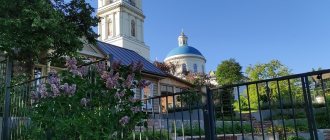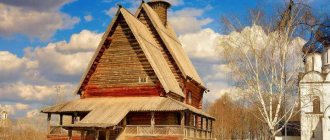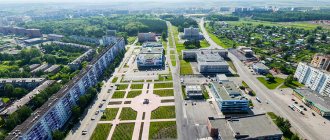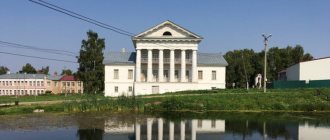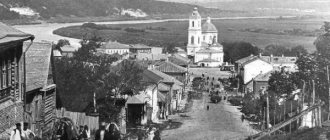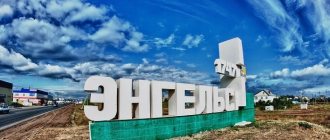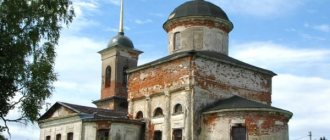Serpukhov is a city near Moscow in which many ancient houses, churches and monasteries have been preserved. The most popular sights of Serpukhov are the Cathedral Mountain with the ancient Trinity Church and the monument to the Soldier-Liberator, the ancient Vysotsky Monastery, the Vladychny Convent, and the Cathedral of St. Nicholas Bely. And also a historical and art museum in the beautiful old Maraev mansion, which is one of the best in the Moscow region.
In the vicinity of Serpukhov there are also interesting sights: the Prioksko-Terrasny Nature Reserve, Drakino Park, Berendeevo Kingdom, an ostrich farm and others.
A few facts about Serpukhov
Hotel and shopping and entertainment complex "Korston"
- Serpukhov is located on the Nara River, in the south of the Moscow region. The Nara divides the city into two parts and flows into the Oka, not far from the city.
- Serpukhov was founded in 1339 and was initially called Serpokhov; only in the 16th century did the modern name come into use.
- It is not precisely established where the name of the city came from, perhaps from the name of the Serpeika river.
- The symbol of the city is the peacock.
- The population of Serpukhov is about 125.4 thousand people.
- The distance from Serpukhov to Moscow is 100 km, to Kaluga -100 km, to Tula - 90 km.
Station building
Address: Serpukhov, Station Square, 1.
In 1868, the tallest civil building, the railway station, was built in Serpukhov according to the design of the architect Fyodor Karlovich Knorre. The station is located at the Serpukhov station of the Kursk direction of the Moscow Railway. The building is not unique; stations in Tula, Kursk, and Ponyri, which were destroyed during the war, were built according to Knorre’s design. Now you can see the twin of the Serpukhov station only in the village of Skuratovo, Tula region.
In front of the station, a fountain was built with a sculptural composition of princes Dmitry Donskoy and Vladimir the Brave on horses standing on a rock. The total height of the composition is 10 meters. The author of the monument is Serpukhov sculptor Ilya Dyukov. The fountain was inaugurated on June 12, 2022.
Cathedral Mountain
Address : Serpukhov, Krasnaya Gora street
Cathedral Mountain (Red Mountain) is the historical center of the city, Serpukhov began from here. Once upon a time there was an ancient Serpukhov Kremlin; now only fragments of the wall remain. On the territory of the Kremlin there is the Trinity Cathedral with a hipped bell tower, built in 1696.
In addition to the church, there are private residential buildings and a memorial dedicated to the Great Patriotic War: a monument to the Liberator Soldier with an Eternal Flame and a mass grave.
Behind the Trinity Cathedral there is an observation deck from where a beautiful view of Serpukhov opens. The most spectacular thing is the architectural ensemble of three beautiful old churches, following each other: Uspenskaya, Ilyinskaya and Trinity. The churches are located at the foot of the hill on Volodarsky Street. The domes of other ancient churches of Serpukhov are also visible here. You can climb to the Cathedral on foot or by car, there is a road.
Serpukhov Kremlin
From St. Nicholas Cathedral it’s a stone’s throw to the oldest landmark – the Serpukhov Kremlin.
A long time ago, on the top of a hill, later called Cathedral Hill, at the confluence of the Nara and Serpeika rivers, an impenetrable fortress rose. The first oak Kremlin was built in 1374, which in 1556 was rebuilt into a white stone one, which completely repeated the configuration of the oak Kremlin.
Towards the end of the 17th century, when Serpukhov lost its military purpose, the Kremlin began to be dismantled. By that time, it was already in a deplorable state, the walls and towers were crumbling, and all the wooden buildings were pretty rotten.
In 1852 - 1853 The Serpukhov Kremlin is recognized as an ancient monument; its remains have been strengthened and partially restored. However, in 1934, an order was received to dismantle the Kremlin for material for the construction of the Moscow metro. Within a year, the Kremlin was dismantled piece by piece and taken to Moscow, however, the stones were declared unsuitable for the Moscow Metro, after which all the building materials were transported to other cities.
Now only two tiny fragments of walls remain on the Kremlin hill. The entire Kremlin was built from white stone, which was abundant in the area. The completely white-stone fortress could have become a unique monument of architecture and history if it had not been completely dismantled. All other kremlins of the same time were made mainly of annealed bricks.
Of all the buildings inside the Kremlin, only the Trinity Cathedral has survived to this day. The first wooden church on this site was built in the 14th century, and the first stone church in the 16th century, which was subsequently rebuilt several times. The cathedral acquired its current appearance in 1837-1841.
In addition to the remains of the Kremlin and the Trinity Cathedral, at the top of the Kremlin hill there is a memorial to the soldiers who died in the Great Patriotic War.
As well as several private houses.
Monument to the Soldier-Liberator
Address: Serpukhov, st. red mountain
Since childhood, everyone knows the famous monument to the Soldier-Liberator by sculptor E. V. Vuchetich in Berlin’s Treptow Park - a Soviet soldier with a sword in one hand, holding a rescued German girl with the other hand. A model of the monument, made in Berlin, was sent to Serpukhov in 1964.
The monument stood for many years near the city hospital named after N. A. Semashko. On June 22, 2009, it was moved to Cathedral Hill, on the territory of the memorial. The height of the Berlin monument is 12 meters, the height of the Serpukhov monument is 2.5 meters. At the foot of the monument burns the Eternal Flame, framed by a symbolic black wreath, charred from the war.
Cathedral of St. Nicholas Bely
Website: nikolabelogo.ru Address: Serpukhov, st. Kaluzhskaya, 26/12.
The Church of St. Nicholas the Bely was built in the 17th century. on the site of a wooden church - it was the first stone church in Serpukhov. Built from hewn blocks of local limestone, the St. Nicholas Church received the name St. Nicholas Bely, which has remained in use to this day.
In 1835-1857, the temple was significantly rebuilt in the Moscow Empire style by architects I.T. Tamansky and F.M. Shestakov, in this form, it has survived to this day.
During Soviet times, St. Nicholas Church was closed (1929), the bell tower was partially destroyed, and some of the icons were burned. It was at this time that the miraculous icon “The Inexhaustible Chalice,” which was kept here after the closure of the Vladychny Monastery, disappeared. The temple was used as a pasta factory; during the war, laundries were located here, then a chemical warehouse. In 1995, the temple was returned to the church as a courtyard of the Vysotsky Monastery, and in 1998 it again became a parish church.
Dome of St. Nicholas Church
The restoration of Nikola Bely was carried out in 1995-2005. In 2003, a five-ton bell for the temple was cast from an alloy of bronze, silver and copper in the Yaroslavl region. It is the largest city bell. In 2005, the temple was solemnly consecrated.
Ensemble of Posad churches
A little ahead, on the site of the former guard tower of the Serpukhov Kremlin, there is an observation deck. It offers a view of Serpukhov's calling card - an ensemble of three churches. Trinity, Assumption and the Church of Elijah the Prophet.
On the opposite side there is a view of the riverside part of the city.
In good weather you can even see the Vysotsky Monastery from here, but in bad weather you can only see an ugly private fence.
The Church of the Assumption of the Blessed Virgin Mary was built in 1744 on the site of an old wooden church. The temple is made in pseudo-Russian style, made of red brick with white carved trim. Be sure to get closer to the Assumption Church to admire the beautiful filigree carvings on the white stone trim.
The Church of Elijah the Prophet was built in 1748, instead of a wooden church, which is considered the oldest church in Serpukhov Posad. In 1844-1847 The dilapidated Elias Church is being rebuilt, replacing the domes and decorating the façade with stucco.
The Church of the Life-Giving Trinity was built in 1670 on the site of a wooden church that burned down in 1669. Trinity Church was poorer than its neighbors, so there were no major reconstructions. In the 1990s. a complete restoration was carried out.
Serpukhov Historical and Art Museum
Website: serpuhov-museum.ru Address : Serpukhov, st. Chekhova, 87. Ticket price: 400 rubles, pensioners - 280 rubles, schoolchildren and students - 240 rubles, preschoolers - free.
The Serpukhov Historical and Art Museum (SIHM) is called the small Tretyakov Gallery; it is considered one of the best art museums in the Moscow region. In the ancient merchant mansion of the Maraev merchants and manufacturers, you can see Western European art of the 16th-19th centuries and works of Russian artists of the 18th - early 20th centuries. The front wing of the mansion was built according to the design of the famous architect Roman Ivanovich Klein in 1896.
Monument to Anna Maraeva in front of the museum building
At the end of the 19th century, the widow Anna Vasilievna Maraeva acquired part of the art collection of the Moscow collector Yu.V. Merlin, presumably as an investment. After the revolution, the paintings acquired by Maraeva became the basis for the creation of the museum.
The Serpukhov Museum was created in 1918. Exhibits came here from the surrounding noble estates (Rai-Semenovskoye, Semenovskoye-Otrada, Rozhdestvenskoye-Telyatyevo, Ostafyevo), monasteries and churches, as well as from Moscow and some towns near Moscow.
White Hall
In addition to paintings, the museum presents a historical exhibition with a model of the Serpukhov Kremlin. The interiors of the old mansion are interesting, the most beautiful and ceremonial of them being the White Hall, decorated in the Empire style. The hall is divided into two parts by snow-white columns. In the first, smaller part of the White Hall there is salon painting, in the second part there are paintings by Ivan Aivazovsky “Tide” and “In the Fog”.
The Serpukhov Museum presents the works of many Russian artists of the 18th - early 20th centuries, the most famous names of them: Rokotov F.S., Levitsky D.G., Savrasov A.K., Levitan I.I., Shishkin I.I., Aivazovsky I.K., Lagorio L.F., Polenov V.D., Vasnetsov V.M. and many others. There are also works by famous Italian, Dutch, French, German and Spanish masters.
Where to go in Serpukhov and what else to see
Cathedral of St. Nicholas Bely
Cathedral of St. Nicholas Bely
The cathedral was founded in 1833 - construction lasted about 25 years. In 1929 it had to be closed. Until 1995, a pasta factory operated in the building. At the end of the 90s, the cathedral was restored and festively consecrated.
Inside, the cathedral is decorated with all kinds of paintings and carved wooden details. Here is a rare icon “Helping Childbirth”, which has healing properties. From the territory of the shrine there are beautiful views of the surroundings of Serpukhov. In addition, it is interesting to look at the cathedral in the evening - the lights turn on, emphasizing its architectural features.
Address: st. Kaluzhskaya, 26/12, Serpukhov
Opening hours: from 7:00 to 18:00
Cost: free
Official website: https://nikolabelogo.ru/
Historical and Art Museum
Historical and Art Museum
The museum was opened in 1920 on the basis of the meeting of the Maraev manufacturers. During the 20-30s, thanks to city funds and estates, the museum was replenished with works of great Russian figures: N.A. Yaroshenko, A.A. Kharlamova, I.I. Levitan and others.
The museum displays sculptures, paintings, ceramics, furniture and household items from the 19th and 20th centuries. His pride is the work of Russian avant-garde artists. Also, many of the museum’s exhibits are the only specimens not only in the city, but also in Russia. They are definitely worth seeing when visiting this beautiful city.
Address: st. Chekhova, 87, Serpukhov
Opening hours: Wednesday, Thursday and Sunday from 10:30 to 17:00, Friday from 10:30 to 20:00, Saturday from 10:30 to 19:00. The ticket office closes half an hour before the museum closes.
Cost: adults - 400 rubles, children and students - 240 rubles, pensioners - 280 rubles.
Official website: serpuhov-museum.ru
Peacock Museum
"Peacock Museum"
The coat of arms of Serpukhov depicts a peacock, which signifies victory, pride and glory. A small exhibition was dedicated to this bird, which then grew into a small but cozy museum.
Various information, sculptures, figurines and images of a peacock are collected here. In the museum you can learn more about the origin of coats of arms and add your own drawing to the exhibition collection. Coffee is offered during the tour.
Address: st. Gorkogo, 5, Serpukhov
Opening hours: Thursday from 12:00 to 20:00, other days from 10:00 to 18:00, Monday - closed
Cost: for children – 30 rubles, for adults – 50 rubles.
Church of the Intercession of the Blessed Virgin Mary
Church of the Intercession of the Blessed Virgin Mary
The church was built in 1910 at the request of the merchants Maraevs, namely the mother of the family. Since 1912, divine services have been actively held, but in 1988 the church was transferred into the ownership of the historical and art museum. Nowadays, services are held occasionally, and classes are organized for schoolchildren.
The eye is attracted by the bright red brick walls and the majestic hipped bell tower. The property of the church is the original iconostasis, dressed in dark wood with gilded details.
Address: st. Chekhova, 81, Serpukhov
Opening hours: Tuesday from 13:00 to 19:00, Saturday from 10:00 to 19:00, Monday - closed, other days from 10:00 to 17:00
Cost: adults – 250 rubles, pensioners – 180 rubles, children – 150 rubles.
Church of All Saints
Church of All Saints
The temple was built in the 1870s according to the design of K.V. Grinevsky. The role of the temple was to bury the dead. But in the 1920s the temple had to be closed, and then it was used as a warehouse. 70 years later, following requests from citizens, renovation work began on the church. In 1995, the temple was consecrated, and he continued work.
In 2010, one of the largest bells weighing 6 tons was installed. The temple was built in the Russian-Byzantine style with elements of Russian architecture, which tourists will really like.
Address: st. Kaluzhskaya, 112, Serpukhov
Opening hours: approximate schedule of services: 7:30 and 16:00
Cost: free
Official website: https://vs-hram.ru/
Trinity Cathedral
Trinity Cathedral
The first prototype of the cathedral was built in 1380. In the following centuries, the church was rebuilt, and now it is shaped like an octagon on a quadruple with a hipped bell tower and a refectory.
The refectory is made in the Baroque style with a distinctive window shape and decoration, which distinguishes the cathedral from other churches. Also, there is a museum of artifacts discovered on the territory of the city’s Kremlin. By visiting this place, you can plunge into the history of the birth of the city and its attractions!
Address : Krasnaya Gora, 12, Serpukhov
Opening hours: Friday and Saturday at 17:00 and 9:00 respectively, check the website for more details
Cost: free entry
Official website: www.tsobor.ru
Museum of Printing
Museum of Printing
The Printing Museum was created entirely with public money. The idea to open a museum came about after the merger of the city’s printing house and the Serpukhov news agency. The exhibition is located in 2 rooms, which reflect the stages of newspaper production.
The museum hosts fascinating excursions, the halls contain objects for editorial activities from different centuries, and the office of the editor of the Kommunist newspaper is presented.
Address: Mishina passage, 2/7, Serpukhov
Opening hours: Saturday and Sunday from 12:00 to 16:00, excursions at 13:00 and 15:00, weekdays by appointment
Cost: from 50 rub.
Musical and Drama Theater
Musical and Drama Theater
The Serpukhov Theater is the only music and drama theater in the Moscow region. It was founded in 1915 by the merchant and singer of the Bolshoi Theater A.A. Govorov.
The theater is exquisitely decorated inside, beautiful chandeliers and velvet seats complete the interior. The theater often announces new productions in different genres with famous actors.
Address: st. Chekhova, 58/27, Serpukhov
Working hours: Monday – closed, other days from 12:00 to 19:00
Cost: ticket price varies between 400 – 2500 rubles. depending on location and premiere
Temple of Seraphim of Sarov
Temple of Seraphim of Sarov
The temple was built in 1915 at the expense of A.I. Konshina. At first the church was intended for doomed patients, but during Soviet times the temple was closed. At the beginning of the 21st century. it has been partially reconstructed.
The temple is unusual in its architecture, similar to a fortress with towers. It is made according to the type of Novgorod churches, popular in the 16th century.
Address: st. Pushkina, 45, Serpukhov
Opening hours: closed entrance, can be viewed from outside
Park of Culture and Leisure named after. Oleg Stepanov
Park of Culture and Leisure named after. Oleg Stepanov
The park of culture and recreation was created in 1875 on the territory of former warehouses and sheds for various goods. Nearby is the city theater. At the beginning of the 20th century. the park was awarded a new status and named in honor of Oleg Stepanov, a hero of the Second World War.
The park has a developed infrastructure, flower beds and attractions are installed, and entertainment programs and concerts are often held here.
Address: st. Staroslobodskaya, 18, Serpukhov
Opening hours: 24 hours a day
Cost: free
Temple of the Savior Not Made by Hands
Temple of the Savior Not Made by Hands
Construction of the temple continued in 1893-1896. financed by merchant V.F. Astapov based on the design of Roman Klein. During Soviet rule, the temple was partially destroyed; now it is being repaired.
The exterior of the temple resembles the “Russian style” in the form of red brick, a dark green roof and white borders on arches and windows; on the walls you can see interesting details of 19th century frescoes. A refectory and a Sunday school are open at the church.
Address: st. Chernyshevsky, 50, Serpukhov
Opening hours: Monday – Thursday from 9:00 to 13:00; Friday from 9:00 to 13:00, from 15:30 to 17:30; Saturday from 8:00 to 13:00, from 15:30 to 18:00; Sunday from 8:00 to 13:00
Cost: free
Official website: https://spasahram.ru/
Train Station
Train Station
The railway station was designed in 1866 by Fedor Knorre, during the period of rapid development and spread of railways. The station became one of the tallest buildings in the Serpukhov district.
The building with its characteristic high windows, arches and a distinctive bright burgundy roof looks aristocratic and elegant. The “Gates” of the city are in no way inferior to its other attractions.
Address: Station Square, 1, Serpukhov
Opening hours: 24 hours a day
Church of the Intercession
Website: serpuhov-museum.ru Address : Serpukhov, st. Chekhova, 81 b. The cost of an excursion ticket is: 250 rubles, for pensioners - 180 rubles, for schoolchildren and students - 150 rubles, for preschoolers - free.
The Intercession Old Believer Church was built in 1910 next to the Maraev estate according to the design of the Moscow architect Mecheslav Piotrovich. In 1906, Anna Maraeva’s 26-year-old daughter Anfisa fell from a horse and died after receiving severe injuries. The Church of the Intercession was built with her dowry. Maraeva donated a family collection of icons from the 15th to 19th centuries to the temple, which can still be seen today. The temple houses a branch of the Serpukhov Historical and Art Museum; you can visit it as part of an excursion.
The peculiarity of the Church of the Intercession is the absence of an altar. The Maraevs belonged to the Old Believers - non-priests who did not recognize the spiritual authority of priests and bishops. Near the temple there is the grave of Anna Maraeva’s eldest daughter, Alexandra Ledneva.
All Saints Church
The Church of All Saints is located next to the Vysotsky Monastery, outside the monastery wall. The temple is notable for the fact that it was built, like the house of Anna Maraeva, by the famous Moscow architect Roman Klein. The customer of the church is the Serpukhov merchant Nikolai Nikolaevich Konshin, it was conceived as the ancestral tomb of the Konshin family.
The Church of All Saints is not like traditional Serpukhov churches. Built in neo-Byzantine style.
Vysotsky Monastery
View of the Vysotsky Monastery from the Nara River
Website: visotskymonastir.ru Address: Serpukhov, Kaluzhskaya st., 5/3.
The Vysotsky Monastery is located on the banks of the Nara River and is one of the oldest Russian church buildings. Founded in 1374 at the behest of local prince Vladimir the Brave. The name comes from the place chosen for the construction of the monastery - Vysokoye.
Conception Cathedral
The main temple of the monastery is the Conception Cathedral; it was built at the end of the 16th century. on the site of a stone temple from 1381, surrounded by covered galleries. One of the most beautiful buildings in Serpukhov is also located on the territory of the Vysotsky Monastery - this is the gate church-bell tower of the Three Great Hierarchs above the western gate. It was built in 1840 in the classicism style, the first tier is a three-arched gate, of which the central arch is the Holy Gate. The second tier is the Church of the Three Saints, on the third tier there is a bell tower, on which a clock by the German master Winter was hung in 1883.
Currently, the monastery is active, here is a list of the Inexhaustible Chalice icon, another list is in the Vladychny Convent of Serpukhov. It is believed that the icon is miraculous and cures alcoholism.
Next to the monastery there is an observation deck on the Nara River, the dam and Serpukhov. If you go down to the river, you can see a small pond where geese and ducks live. The towers and walls of the monastery have been preserved.
Attractions in the vicinity of Serpukhov
Pavlenskoye Lake
Pavlenskoye Lake
The lake is located not far from the Oka and is connected to it by a small channel. In essence, a reservoir is a river bay. The depth of the lake reaches 4 meters and the length is 2 km.
People come here to admire the beauty of the landscape, swim and fish. The lake is home to bream, roach, perch, etc. The shore is pleasant, sandy, and in some places rocky areas allow you to see the bottom and marine life.
Address: Pavlenskoye, Moscow region; GPS: 54.88333, 37.44527
Farm "Russian Ostrich"
Farm "Russian Ostrich"
The farm was founded in 1999 and since then has been successfully breeding and keeping African ostriches in harsh Russian conditions. The farm area is 3 hectares. During the excursion, you can feed ostriches and other animals, make a toy or figurine, attend master classes and mini-lessons.
In addition to interesting animals and an educational program, there is the opportunity to try nutritious meat and an omelet made from huge ostrich eggs.
Address: village Starye Kuzmenki; GPS: 55.04344, 37.40951
Opening hours: in winter from 10:00 to 16:00, in summer from 10:00 to 17:00
Cost: regular excursion time – 1 hour, 350 rubles.
Turovo Estate
Turovo Estate
Previously, Turovo belonged to Dmitry Artsybashev, a Decembrist and politician. After Dmitry was sent to the Caucasian War, the estate was transferred to Serpukhov. Only a small outbuilding, decorated with medallions and a mezzanine, has survived to this day.
Turovo is made in the style of classicism and fits perfectly with the nature of these places. Important buildings are the Church of the Nativity of the Blessed Virgin Mary and the towering bell tower.
Address: Oktyabrskaya st., 5, Turovo village; GPS: 54.87742, 37.82429
Church of the Nativity of the Virgin Mary
Church of the Nativity of the Virgin Mary
The church is located in the village of Podmoklovo near Serpukhov. Construction was completed in 1754. Until 1936, services were held, but then the church was closed. It began operating normally in 1992.
The Shrine of the Nativity of the Virgin Mary is a building from the Peter the Great era in the Western European Baroque style, which was popular in the 16th century. It is worth paying attention to the well-designed architecture of the church. Inside the temple you can buy souvenirs and interesting literature.
Address: Podmoklovo village; GPS: 54.86694, 37.34664
Opening hours: weekdays – closed, Saturday from 16:00 to 18:00, Sunday from 9:00 to 11:00
Cost: free
Official website: https://www.hram-podmoklovo.ru/
Dam on Nara
Dam on Nara
The dam was built over the course of 1 year, and was opened in 1931. The main materials are cement and concrete. The dam performs several functions: it supplies residents with water and controls the river level.
In summer there is a picturesque view of the banks of the Nara, the atmosphere is inspiring and relaxing.
Address: Nara, Moscow region; GPS: 54.90353, 37.41488
Prioksko-Terrasny Reserve
Prioksko-Terrasny Reserve
The area of the reserve is about 4945 hectares, the area of the reservoir on the territory is about 12 hectares. This is one of the smallest nature reserves in Russia and the only one in the Moscow region.
The reserve features hundreds of species of mammals and plants. The flora and fauna are so diverse that neither adults nor children will be bored. This place is also considered the cleanest near the capital.
Address: Danki, Moscow region; GPS: 54.91112, 37.57181
Working hours: from 9:00 to 15:00, seven days a week
Cost: adults – 400 rubles, children – 200 rubles, disabled people, orphans – 50% discount, preschoolers – free
Estate Pushchino-on-Oka
Estate Pushchino-on-Oka
The estate is located on the banks of the Oka River in the city of Pushchino. In 1578-1699 the estate belonged to the Pushchins. The estate has quite a rich history, as its owners often changed. Of the entire ensemble, only the house and parts of the staircase have survived to this day.
The estate will be of interest to lovers of active recreation. A trail runs through its territory; its length reaches 4 km. There is a small pond nearby where you can rent a boat or motorboat.
Address: Pushchino, Moscow region; GPS: 54.83997, 37.60352
Estate Pushchino-on-Nara
Estate Pushchino-on-Nara
The estate was built at the end of the 16th century. on the banks of the Nara S.I. Vyazemsky. It belonged to the princes of the same name. The estate was occasionally restored and updated, but its original appearance has survived to this day. Its appearance changed only in Soviet times: it was dismantled for building materials.
On the pediment of the estate you can see elements of complex decor and a Greek portico, fragments of a fountain and outbuildings. The landscape of the ancient building is complemented by linden alleys.
Address: Pushchino, Moscow region; GPS: 54.93876, 37.36067
Bison nursery
Bison nursery
The bison nursery is located on the territory of the Prioksko-Terrasny Nature Reserve. It was created to preserve the bison population. About 200 hectares of land have been allocated for the nursery.
The bison nursery is a great place to see how bison live in their natural environment. There are fascinating excursions here, and there is a place nearby to have a snack and buy souvenirs.
Address: located on the territory of the Prioksko-Terrasny Nature Reserve; GPS: 54.91112, 37.57181
Opening hours: weekdays from 09:00 to 17:00, weekends from 09:00 to 18:00, excursions every day from 9:00 to 16:00
Cost: adults - 400 rubles, children (6-17 years old) - 200 rubles.
Prinarsky Park
Website: prinarskiy-park.ru Address: Serpukhov, Teatralnaya street. Opening hours: daily from 06:00 to 22:00.
Prinarsky Park opened in Serpukhov in 2014. Along the Central Alley of this landmark of Serpukhov you can go to the dam and the Vysotsky Monastery. On the alley you can see a monument to Saints Peter and Fevronia - the most publicized saints in Russia; monuments to them can be seen in almost every city. The park has children's playgrounds and benches, the "Happiness Is" cafe, and gazebo houses with barbecues that are for rent.
“Made with us” and on Yandex.Zen
If you look closely, in the panoramas of beautiful churches (especially shots from above) you can see the abandoned workshops of the Serpukhov textiles, on the other side of the Cathedral Hill, the buildings of the former mechanical plant, which are gradually being converted into trading. I call these buildings monuments to the Yeltsin-Gaidar-Kudrin economy...Serpukhov textile (before that the Red Textile Worker) in the recent past was a powerful light industry enterprise that produced a wide range of both fabrics and finished products from them (as a child I found a shirt on the label of which it was written "Red textile worker. Serpukhov" and was very proud of her).
Also, in recent years, the Motoprom Research Institute and the Nonwoven Materials Research Institute have turned, respectively, into the Samokhval shopping center (this name quickly fell into oblivion and now there are many stores there) and Pyaterochka, respectively. the dairy plant (which at one time supplied products even to the Kremlin) and the meat processing plant (which supplied products to the army) were abandoned. In general, the historical part of the city, where factories of famous Serpukhov families such as the Konshins, for example, once flourished, and Soviet times were bustling with life, now personifies the desolation and devastation of the 90s (when many believed that nothing was profitable in Russia and they will give us everything).
From the production facility located in Serpukhov:
OJSC RATEP (part of Almaz-Antey) produces equipment for the Navy, and also had a separate plant division for the production of civilian products: meat grinders and coffee grinders. Now, according to rumors, they are either alive or not. The plant also tried to produce mini-loaders (I wrote an article about this on the website) but it didn’t work out for them. In the spring, there was a slight staff reduction at the plant (this means that compared to Soviet times, the workshops already looked deserted). the same can be said about the Metalist plant, which in Soviet times worked for the defense industry.
A Veles LLC plant has recently opened in the city for the production of natural (as they say) meat products (sausages, frankfurters, etc.). As stated, the meat is taken from Miratorg, there are several tents around the city. I bought the product and liked it.
There is also a fairly strong enterprise, OJSC Serpukhovkhleb, with a wide range of bakery and confectionery products. The plant also opened a network of stores for its products throughout the city, since getting into the network is becoming more and more difficult every year. Just recently the Dixie chain stopped purchasing products from our bakery. According to information from inside, they requested too large a rollback. This is despite the fact that the networks are already twisting the arms of local producers.
The Serpukhov Tannery still operates in the city. CJSC Serpukhov Tannery is one of the oldest enterprises in Russia with a rich history and traditions, founded in 1781. Today it is a modern enterprise that processes all types of leather raw materials using the most advanced technologies using materials from the world's leading companies. More than 1000 articles of high-quality chrome leather are produced: shoe, lining, haberdashery, clothing and gloves.
You can also remember the famous Rollton, but in fact this campaign works and pays taxes to the Serpukhov region. By the way, the regional industrial life seems to me to be more active than the city one. Recently, an elevator plant (which is currently experiencing certain difficulties) and a Turkish tile and sanitary ware plant, Vitra, have opened there
Vvedensky Monastery
Vvedensky Cathedral
Website: www.inokini.ru Address: Serpukhov, st. Oktyabrskaya, house 40.
The Vvedensky Vladychny Convent is located 3.5 kilometers from the Vysotsky Monastery on the other bank of the Nara River. It was founded in 1360 as a monastery and became a monastery for women in 1806. The miraculous icon of the Mother of God, the Inexhaustible Chalice, healing from alcoholism, appeared, according to legend, in the Vladychny Monastery.
Since ancient times, peacocks have been bred in the monastery, which is why the peacock became a symbol of Serpukhov. There are many flower beds and greenery in the monastery. Baked goods and honey are sold here. Next to the monastery there is an Orthodox classical gymnasium in the name of St. Varlaam of Serpukhov, where children study from grades 1 to 11 according to a general education program with an Orthodox bias.
Sovetskaya Street
We reached the first attraction of Serpukhov along Sovetskaya Street in 20 minutes. This section of the street is built up, for the most part, with Soviet five-story buildings.
At the intersection of Sovetskaya and Gorky streets on Glory Square in 2017, the Eternal Flame was lit and a stele of Military Valor was installed. Serpukhov is the fifth city in the Moscow region in which such a stele was installed.
In the background is the graffiti “Warriors of the Ages”. This graffiti combines all the key moments in the military history of Serpukhov: the Battle of Kulikovo in 1380, the Patriotic War of 1812 and the Great Patriotic War of 1941-1945. The central figure of the composition is Prince Vladimir the Brave of Serpukhov.
A little further along Sovetskaya Street there is a monument to Prince Vladimir the Brave.
The appanage prince of Serpukhov, Vladimir Andreevich, was born in the middle of the 14th century and went down in history as a commander and defender of the Russian land. For his participation in numerous military campaigns he was nicknamed the Brave. It was during his reign that Serpukhov experienced favorable times, developed and was actively built up, and at the same time, the Vysotsky Monastery was founded not far from the city.
The monument to Vladimir the Brave is erected opposite the Serpukhov city administration.
